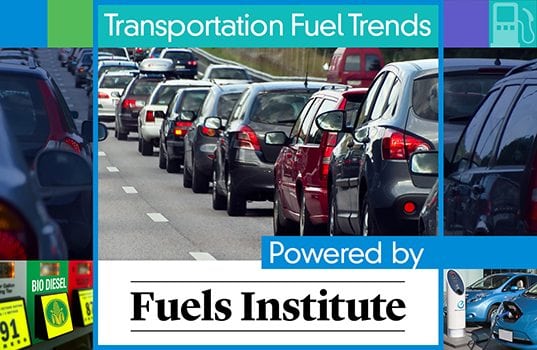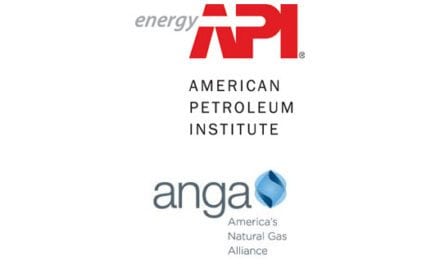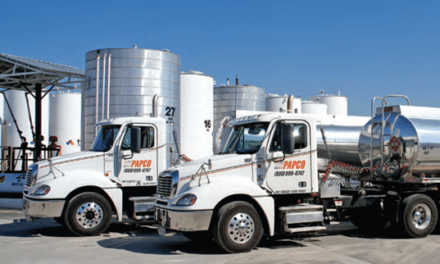Understanding how fuel efficiency standards are implemented and what they mean for fuel consumption is critical.
By John Eichberger
Editor’s Note: FMN Will be working to support the efforts of the Fuels Institute. The Fuels Institute is a research-oriented think tank founded and managed by NACS, dedicated to evaluating the market issues related to consumer vehicles and the fuels that power them. We will regularly run materials developed by the institute, as appropriate, for the education of our readers. This piece previously ran in the September 2014 issue of NACS Magazine.
Fuel demand is a product of fuel efficiency and miles traveled. The federal government has enacted more stringent requirements for overall fleet efficiency, and this will contribute to reduced demand for traditional petroleum products and enhance the incentive for automakers to deliver to market advanced systems that will rely on products other than hydrocarbons. How this will translate into market realities remains to be seen, but already some conflicting indicators give us pause.
CAFE Is on Pace
It looks like the automobile industry is on schedule for meeting Corporate Average Fuel Economy (CAFE) standards for model year 2016, having exceeded projections for the past two years. WardsAuto reports that the July fleet economy average was 25.3 mile per gallon — a 2.3% improvement over year prior. Cars sold in July averaged 29.7 mpg and light trucks average 21.1 mpg. In terms of who is leading the charge on fuel efficiency, Asia-Pacific automakers averaged 27.6 mpg compared with 22.7 mpg for domestic and 25.0 mpg for European manufacturers.
Some significant improvements are still required if the industry is expected to meet the 2016 fuel efficiency requirement of nearly 36 mpg, but there has been considerable progress. It’s the 2025 target of 54.5 mpg that might be more of a challenge.
In understanding the effect of fuel efficiency on fuel demand, it is important to recognize the distinction between the regulatory specification and the anticipated real world performance. On the regulatory side, there are two CAFE standards: one issued by EPA that is calculated as a greenhouse gas equivalent fuel economy, and one issued by the National Highway Transportation Safety Administration, which is a pure miles per gallon standard. EPA has issued their GHG-Equivalent standard through 2025, but NHTSA is restricted to setting standards in five-year increments. Consequently model year 2022 and later standards are projected only. EPA’s 2025 GHG-Equivalent is a combined 54.5 mpg; NHTSA’s projected combined standard is 49.7 mpg.
Another factor to consider is that the regulated CAFE standard is different from what consumers will see on the label on their car. The CAFE regulation includes various credits, incentives and adjustments available to the automaker and incorporates what is known as 2-cycle testing. In this situation, vehicles are tested to estimate efficiency in urban and rural highway driving. The mpg printed on the label that is affixed to a vehicle, by contrast, uses a 5-cycle testing protocol that adds factors such as high speed/acceleration, high temperature/air conditioning and cold temperature operation. EPA reports that the mpg reported on the label averages 20% to 25% lower than those recorded for CAFE compliance.
Recent improvements in fuel efficiency have been achieved by incorporating a number of innovations, including mass reduction strategies, implementation of advanced transmission systems (up to nine gears, continuously variable and dual-clutch), hybridization, expansion of diesel variants, cylinder deactivation, stop-start technology, higher compression ratios, smaller turbo-boosted engines, direct injection and forced induction and so on. To achieve the EPA GHG-Equivalent standard, automakers can also improve the emissions profile of their internal operations, including cabin climate control and electrical system efficiency improvements. These may not translate directly into more miles per gallon, but they will help satisfy EPA standards.
Fuel Consumption Unclear
These fuel efficiency improvements often are cited as the driving force behind anticipated reduction in gasoline sales and are expected to help drive down consumption. In December 2013, the U.S. Energy Information Administration (EIA) forecast that gasoline sales would decline 14.4% between 2014 and 2025. EIA historic data show that demand already dropped 5.5% from 2007 to 2013. Similarly, in the Fuels Institute’s “Tomorrow’s Vehicles” report, Navigant Research forecasts gasoline demand will drop between 18.5% to 21.8% by 2023.
However, data contradicts the EIA report and some observers question if the market for gasoline is contracting at all. NACS CSX data seems to support this opinion and shows that same store average monthly gasoline sales through May 2014 have increased 6.7% since 2007. Last year, however, was up 10.8% over 2007. This represents an annualized rate of growth of 0.7%. In addition, OPIS (Oil Price Information Service) recently began tracking consumption data and consistently shows volumes higher than those reported by EIA.
If the detractors to EIA’s forecast are correct, this would have serious repercussions on industry strategies when determining what products to sell and how to preserve customer traffic in a declining fuel demand market. In addition, the current heated debate in Washington concerning the future of the Renewable Fuel Standard would take on a very different tone if demand is increasing rather than disappearing.
Consider this: If the annual growth rate reported by CSX companies since 2007 is sustained through 2025, this would equate to a cumulative demand increase of 3.9%. This stands in contrast to the EIA forecast drop of 14.4%. Using EIA’s forecast and reported gasoline volume for 2013, the difference in annual gasoline consumption is approximately 11 billion gallons to 122.8 billion versus 143.5 billion.
Having a better understanding of how fuel efficiency standards are implemented and what they mean for fuel consumption is critical for retailers evaluating where to make investments, for policymakers to evaluate the effect of existing or pending regulations, and for the automobile industry to evaluate how quickly to bring new fuel technologies to market. In this arena, however, many questions have yet to be answered.
 For more information about the Fuels Institute or how you can get involved, contact John Eichberger, executive director, at [email protected] or (703)518-7971. The Fuels Institute Annual Meeting is November 17-19, in Southern California. You are invited to register for this open meeting and we are planning a fantastic agenda. In addition to discussions on key issues facing the transportation fuels market, we will also be visiting retail facilities that dispense hydrogen and natural gas, as well as visit with experts at Toyota to learn more about advanced vehicle technologies. Registration information will be available in the near future. In the meantime, join the conversation online at Facebook and Twitter. By sharing information and opinions with one another, we can create a sustainable transportation fuels market.
For more information about the Fuels Institute or how you can get involved, contact John Eichberger, executive director, at [email protected] or (703)518-7971. The Fuels Institute Annual Meeting is November 17-19, in Southern California. You are invited to register for this open meeting and we are planning a fantastic agenda. In addition to discussions on key issues facing the transportation fuels market, we will also be visiting retail facilities that dispense hydrogen and natural gas, as well as visit with experts at Toyota to learn more about advanced vehicle technologies. Registration information will be available in the near future. In the meantime, join the conversation online at Facebook and Twitter. By sharing information and opinions with one another, we can create a sustainable transportation fuels market.












